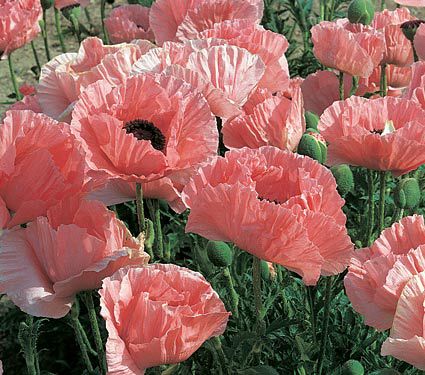






Oriental Poppy: Exotic Color for the Late-Spring Garden
The romance of the Oriental Poppy (Papaver orientale) is fully justified by its huge, crepe-petaled blooms; these flaunt their gorgeous pinks, reds, oranges, or whites in May or June like silken swatches spread across some central Asian bazaar. Borne atop stems 2 1/2 to 4 feet tall, Oriental Poppy blossoms last only a week or two, but during that season furnish one of the high points of the gardening year. The dense mound of finely cut, downy foliage provides a handsome setting for the flowers while adding greatly to the texture of bed or border.
Enduring Perennials
We've known oriental Poppies to bloom faithfully for decades when their modest needs -- a sunny spot and well-drained, moderately fertile, soil -- have been satisfied. Winter hardy virtually anywhere in the continental United States, Oriental Poppies are also outstandingly tolerant of summer drought, since they retreat underground into dormancy soon after flowering. To fill the gap created by the Oriental Poppies' disappearance, we pair them with expansive summer-blooming annuals such as Baby's Breath or Dahlias, or bold, summer-blooming perennials and Asiatic Lilies.
Oriental Poppies for the Cutting Garden
Oriental Poppy blossoms offer superb material for indoor arrangements. Cut in early morning when the buds are just unfolding, searing the stem's cut end with the flame of a match.
What We Ship
Unless otherwise noted in the description, we send Oriental Poppies bareroot at the appropriate time for fall planting.
Oriental Poppy - How to Care for Your Plant
Light/Watering: Plants need a full eight hours of sun to flower well. While they are drought tolerant once established, give them an inch of water a week when in bud or bloom. Do not overwater when plants are dormant.
Fertilizer/Soil and pH: Soil should have a pH of 6.5 to 7.0 and be well drained, as plants will not tolerate wet soils in winter, which rot the fleshy roots. Apply a slow-release fertilizer in spring, or side-dress with compost or aged manure. When planting bareroot plants, soil should be deeply prepared and the crown covered with three inches of soil.
Pests/Diseases: Oriental Poppies are seldom bothered by insects or disease. During extended wet weather buds may blacken and fail to open. Fungicides may be employed to help prevent this problem.
Companions: Plant behind large perennials like Siberian Iris, Baby's Breath or herbaceous Peonies to camouflage the hole left behind when Poppies go dormant in summer. Filling in with annuals such as Nicotiana or Cosmos is also effective.
Reflowering: Since deadheading does not reward the gardener with repeat bloom, you may choose to leave the flowers on the plant for the interesting seed pods that follow.
Dividing/Transplanting: Poppies have deep taproots that may make transplanting a challenge. Division is needed only every five years or so and the best time to divide or transplant is in August when plants are dormant.
End of Season Care: Leave any new foliage on the plant. When soil has frozen to an inch deep, apply evergreen boughs or pine needles to buffer soil temperature and help prevent the crowns from being heaved out of the soil.
Calendar of Care
Early Spring: Check soil pH and adjust to 6.5 to 7.0 if needed. Apply a slow-release fertilizer or side-dress with compost or aged manure.
Mid-Spring: Apply a fungicide if extended wet weather has caused plants to become diseased.
Summer: Plant annuals to fill in holes left by dormant plants if needed. Do not overwater dormant plants. Divide or transplant Poppies in August when they are dormant.
Fall: Leave new foliage alone, and mulch with a loose material like evergreen boughs or pine needles after the soil has frozen to a depth of one inch.
Copyright © www.100flowers.win Botanic Garden All Rights Reserved